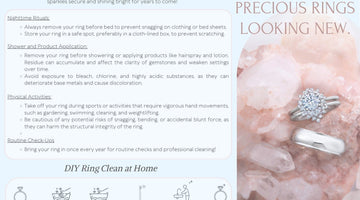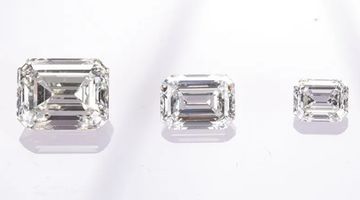Beyond the 4Cs: What Really Impacts Diamond Beauty and Value
When buying a diamond, most people focus on the 4Cs—Cut, Clarity, Carat, and Color. While these are essential grading factors, they don’t tell the whole story. According to studies published by leading gemological institutes (e.g., GIA and AGS), two diamonds with identical 4C grades can look dramatically different in real life due to nuances not captured in a certificate.
At The Classic Gem, we take diamond selection beyond the 4Cs, applying our 8-Point Diamond Screening Process to ensure each diamond meets our high standards for brilliance, transparency, and durability. By doing so, we aim to deliver diamonds that consistently exceed expectations in both appearance and longevity.
The Basics: The 4Cs of Diamond Buying
-
Cut
The single most important factor affecting a diamond’s brilliance. Cut grades range from Poor to Excellent and reflect how effectively a diamond interacts with light. Research suggests that a well-proportioned diamond can reflect up to 90–95% of the light it receives, whereas a poorly cut stone may reflect significantly less, appearing dull or lifeless—even with good color and clarity. -
Clarity
Measures the presence of inclusions and blemishes inside a diamond. Clarity grades range from Flawless (no visible inclusions under 10x magnification) to Included (visible inclusions to the naked eye). However, the location of these inclusions can matter just as much as the overall clarity grade. -
Carat
Refers to the diamond’s weight. One carat equals 200 milligrams—but two diamonds of the same carat weight can differ in perceived size based on their cut proportions. For example, a deeper-cut 1.00-carat diamond may look smaller than a well-cut 1.00-carat diamond with optimal proportions. -
Color
Graded from D (colorless) to Z (light yellow or brown). A colorless diamond allows more light to pass through, enhancing brilliance. However, color alone won’t guarantee beauty if other factors (like cut or undertones) aren’t up to par.
Despite how critical the 4Cs are, they don’t capture every aspect that contributes to a diamond’s true beauty, durability, and value.
What the 4Cs Don’t Tell You: Hidden Factors That Impact Beauty
Many visual and structural characteristics of a diamond aren’t included on a grading report. Industry experts note that up to 10–15% of diamonds within a given 4C range may display noticeable nuances like milkiness or undesirable undertones that significantly affect their overall appearance.
1. Milkiness (Cloudiness)
A diamond can look hazy or lifeless due to microscopic pinpoints that scatter light. Known colloquially as “milky” or “cloudy” diamonds, they often appear dull under normal lighting.
- Some diamonds may have only a slight milky undertone, whereas others show an outright foggy appearance.
- Even a D-Flawless diamond can look unappealing if it has strong milkiness, as it inhibits light transmission.
- In many online listings, milkiness may go undisclosed and be sold at lower prices to attract less discerning buyers.

2. Brown, Green, or Gray Tints (BGM)
Some diamonds exhibit undesirable undertones—often described collectively as BGM (Brown, Green/Gray, Milky).
- Brown Tint (Top Light Brown/TLB): Even a subtle brown hue can make a diamond appear warmer or darker than its graded color.
- Green/Gray Tint: Can be caused by structural defects, radiation exposure, or trace elements, giving the stone an off-color look in daylight.
- Milky Tints: Affects transparency, diminishing overall brilliance.
According to trade estimates, diamonds with these tints may sell at a 10–30% discount compared to similar 4C-graded stones without these nuances. However, buyers may end up with a stone that lacks the crisp sparkle of a high-quality diamond.

3. Structural Integrity & Durability
Even a diamond with high clarity can be internally weak if it has extremely thin girdles, extensive graining, or inclusions in high-stress areas. Such weaknesses increase the risk of chipping or damage over time, making durability a major concern for daily-wear pieces like engagement rings.
The Classic Gem 8-Point Diamond Screening Process
At The Classic Gem, our 8-Point Diamond Screening Process looks beyond what’s on a grading certificate to ensure a diamond’s brilliance, beauty, and durability truly stand out.
-
Cut Precision & Light Performance
We evaluate each diamond’s angles, proportions, and symmetry to ensure it maximizes sparkle and fire, performing optimally under different lighting conditions. -
Structural Integrity & Durability
We check for thin girdles, internal stress fractures, or weak points that could lead to chipping. This ensures your diamond not only looks stunning but remains robust for everyday wear. -
Transparency & Milkiness Check
Diamonds should be crystal clear—not cloudy. We screen for milky or hazy appearances that aren’t noted on certificates but can significantly diminish brilliance. -
Symmetry & Proportions
Even minor deviations in crown angles, pavilion depth, or table size affect a diamond’s light performance. We ensure precision in these areas for maximum brilliance. -
Fluorescence & Visual Impact
Studies by the GIA show that strong fluorescence can occasionally give a diamond an oily or hazy look. We inspect each stone under UV light to confirm that fluorescence either enhances or remains neutral to the diamond’s overall appearance. -
Color Precision & Undertones
Not all diamonds of the same color grade look alike. We eliminate those with unwanted brown, green, or gray undertones and focus on stones with bright white or crisp color. -
Eye Cleanliness & Inclusion Placement
Some inclusions are well-hidden, while others impact a diamond’s brilliance and durability. We ensure diamonds are eye-clean and free from inclusions in critical areas, preserving both beauty and structural soundness. -
Value & Market Comparisons
We compare each diamond against global market data to ensure competitive pricing without sacrificing quality. Unlike mass retailers, we only source top-tier stones, often representing the top 1–2% of the market.
Why This Matters: Investing in True Beauty and Value
Buying a diamond isn’t just about finding the highest 4C grades—it’s about choosing a stone that looks exceptional in real life and stands the test of time.
By applying our 8-Point Diamond Screening Process, The Classic Gem ensures you receive:
- A diamond with maximum brilliance and sparkle
- A stone free from unwanted undertones or milky appearance
- Excellent durability and craftsmanship
- The best value for your investment, backed by in-depth market comparisons
Many commercial jewelers offer diamonds straight from a supplier’s list, prioritizing cost over quality. At The Classic Gem, we personally inspect and hand-pick every diamond, guaranteeing that only the finest stones become part of our inventory.
If you’re looking for a diamond that stands out—one that sparkles brilliantly, boasts impeccable craftsmanship, and is engineered for durability—we’d love to guide you through the process.


